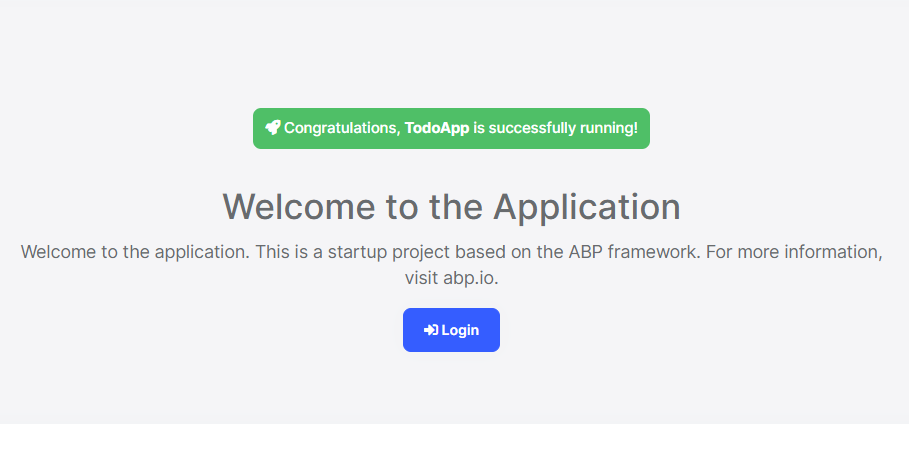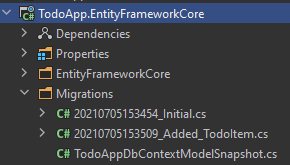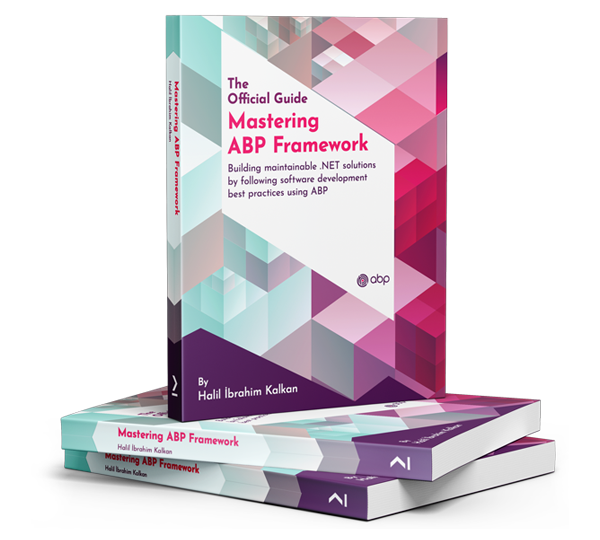Quick Start
This is a single-part quick-start tutorial to build a simple todo application with the ABP Framework. Here's a screenshot from the final application:

You can find the source code of the completed application here.
This documentation has a video tutorial on YouTube!! You can watch it here:
Pre-Requirements
- An IDE (e.g. Visual Studio) that supports .NET 8.0+ development.
- Node v16.x
Install ABP CLI Tool
We will use the ABP CLI to create new ABP solutions. You can run the following command on a terminal window to install this dotnet tool:
Create Your ABP Solution
Create an empty folder, open a command-line terminal and execute the following command in the terminal:
This will create a new solution, named TodoApp. Once the solution is ready, open it in your favorite IDE.
Create the Database
If you are using Visual Studio, right click on the TodoApp.DbMigrator project, select Set as StartUp Project, then hit Ctrl+F5 to run it without debugging. It will create the initial database and seed the initial data.
Some IDEs (e.g. Rider) may have problems for the first run since DbMigrator adds the initial migration and re-compiles the project. In this case, open a command-line terminal in the folder of the
.DbMigratorproject and execute thedotnet runcommand.
Before Running the Application
Installing the Client-Side Packages
ABP CLI runs the abp install-libs command behind the scenes to install the required NPM packages for your solution while creating the application.
However, sometimes this command might need to be manually run. For example, you need to run this command, if you have cloned the application, or the resources from node_modules folder didn't copy to wwwroot/libs folder, or if you have added a new client-side package dependency to your solution.
For such cases, run the abp install-libs command on the root directory of your solution to install all required NPM packages:
We suggest you install Yarn to prevent possible package inconsistencies, if you haven't installed it yet.
Run the Application
It is good to run the application before starting the development. Ensure the TodoApp.Web project is the startup project, then run the application (Ctrl+F5 in Visual Studio) to see the initial UI:

You can click on the Login button, use admin as the username and 1q2w3E* as the password to login to the application.
All ready. We can start coding!
Domain Layer
This application has a single entity and we'll start by creating it. Create a new TodoItem class inside the TodoApp.Domain project:
BasicAggregateRoot is the simplest base class to create root entities, and Guid is the primary key (Id) of the entity here.
Database Integration
Next step is to setup the Entity Framework Core configuration.
Mapping Configuration
Open the TodoAppDbContext class in the EntityFrameworkCore folder of the TodoApp.EntityFrameworkCore project and add a new DbSet property to this class:
Then navigate to the OnModelCreating method in the TodoAppDbContext class and add the mapping code for the TodoItem entity:
We've mapped the TodoItem entity to the TodoItems table in the database.
Code First Migrations
The startup solution is configured to use Entity Framework Core Code First Migrations. Since we've changed the database mapping configuration, we should create a new migration and apply changes to the database.
Open a command-line terminal in the directory of the TodoApp.EntityFrameworkCore project and type the following command:
This will add a new migration class to the project:

You can apply changes to the database using the following command, in the same command-line terminal:
If you are using Visual Studio, you may want to use the
Add-Migration Added_TodoItemandUpdate-Databasecommands in the Package Manager Console (PMC). In this case, ensure thatTodoApp.Webis the startup project andTodoApp.EntityFrameworkCoreis the Default Project in PMC.
Now, we can use the ABP repositories to save and retrieve the todo items, as we'll do in the next section.
Application Layer
An Application Service is used to perform the use cases of the application. We need to perform the following use cases:
- Get the list of the todo items
- Create a new todo item
- Delete an existing todo item
Application Service Interface
We can start by defining an interface for the application service. Create a new ITodoAppService interface in the TodoApp.Application.Contracts project, as shown below:
Data Transfer Object
GetListAsync and CreateAsync methods return TodoItemDto. ApplicationService typically gets and returns DTOs (Data Transfer Objects) instead of entities. So, we should define the DTO class here. Create a new TodoItemDto class inside the TodoApp.Application.Contracts project:
This is a very simple DTO class that matches our TodoItem entity. We are ready to implement the ITodoAppService.
Application Service Implementation
Create a TodoAppService class inside the TodoApp.Application project, as shown below:
This class inherits from the ApplicationService class of the ABP Framework and implements the ITodoAppService that was defined before. ABP provides default generic repositories for the entities. We can use them to perform the fundamental database operations. This class injects IRepository<TodoItem, Guid>, which is the default repository for the TodoItem entity. We will use it to implement the use cases described before.
Getting Todo Items
Let's start by implementing the GetListAsync method:
We are simply getting the complete TodoItem list from the database, mapping them to TodoItemDto objects and returning as the result.
Creating a New Todo Item
Next method is CreateAsync and we can implement it as shown below:
The repository's InsertAsync method inserts the given TodoItem to the database and returns the same TodoItem object. It also sets the Id, so we can use it on the returning object. We are simply returning a TodoItemDto by creating from the new TodoItem entity.
Deleting a Todo Item
Finally, we can implement the DeleteAsync as the following code block:
The application service is ready to be used from the UI layer.
User Interface Layer
It is time to show the todo items on the UI! Before starting to write the code, it would be good to remember what we are trying to build. Here's a sample screenshot from the final UI:

We will keep the UI side minimal for this tutorial to make the tutorial simple and focused. See the web application development tutorial to build real-life pages with all aspects.
Index.cshtml.cs
Open the Index.cshtml.cs file in the Pages folder of the TodoApp.Web project and replace the content with the following code block:
This class uses the ITodoAppService to get the list of todo items and assign the TodoItems property. We will use it to render the todo items on the razor page.
Index.cshtml
Open the Index.cshtml file in the Pages folder of the TodoApp.Web project and replace it with the following content:
We are using ABP's card tag helper to create a simple card view. You could directly use the standard bootstrap HTML structure, however the ABP tag helpers make it much easier and type safe.
This page imports a CSS and a JavaScript file, so we should also create them.
Index.js
Open the Index.js file in the Pages folder of the TodoApp.Web project and replace it with the following content:
In the first part, we are subscribing to the click events of the trash icons near the todo items, deleting the related item on the server and showing a notification on the UI. Also, we are removing the deleted item from the DOM, so we don't need to refresh the page.
In the second part, we are creating a new todo item on the server. If it succeeds, we are then manipulating the DOM to insert a new <li> element to the todo list. This way we don't need to refresh the whole page after creating a new todo item.
The interesting part here is how we communicate with the server. See the Dynamic JavaScript Proxies & Auto API Controllers section to understand how it works. But now, let's continue and complete the application.
Index.css
As the final touch, open the Index.css file in the Pages folder of the TodoApp.Web project and replace it with the following content:
This is a simple styling for the todo page. We believe that you can do much better :)
Now, you can run the application again and see the result.
Dynamic JavaScript Proxies & Auto API Controllers
In the Index.js file, we've used the todoApp.todo.delete(...) and todoApp.todo.create(...) functions to communicate with the server. These functions are dynamically created by the ABP Framework, thanks to the Dynamic JavaScript Client Proxy system. They perform HTTP API calls to the server and return a promise, so you can register a callback to the then function as we've done above.
However, you may notice that we haven't created any API Controllers, so how does the server handle these requests? This question brings us to the Auto API Controller feature of the ABP Framework. It automatically converts the application services to API Controllers by convention.
If you open the Swagger UI by entering the /swagger URL in your application, you can see the Todo API:

Conclusion
In this tutorial, we've built a very simple application to warm up for the ABP Framework. If you are looking to build a serious application, please check the web application development tutorial which covers all the aspects of real-life web application development.
Source Code
You can find source code of the completed application here.


 Limited Time Offer!
Limited Time Offer!



